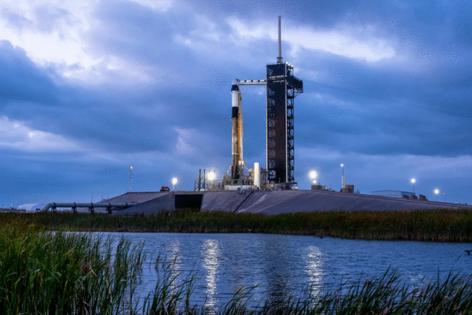Private SpaceX mission launches humans on 1st polar orbit
Published in Science & Technology News
SpaceX launched a private mission Monday night sending humans on the first polar orbit of the Earth.
The four civilians climbed aboard the Crew Dragon Resilience on Monday night, launching atop a Falcon 9 rocket from Kennedy Space Center at 9:46 p.m.
The rocket rumbled off Launch Pad 39-A with a hail of thunderstorms lighting up the sky in the distance. KSC had been under lightning and hail warnings as a storm with 40 mph winds, and a front blew through as the crew climbed aboard at the pad.
The rocket path sent it south from KSC toward South Florida, creating a unique blue-and-orange plume in the night sky billowing out like a jellyfish. The trajectory takes it over Cuba and then off the Pacific Coast of South America.
Footing the bill for the flight is Chinese-born Chun Wang of Malta, an entrepreneur who made a fortune in cryptocurrency and an avid adventurer. What he’s paying has not been announced, but a similar private mission run by Axiom Space but contracting with SpaceX for use of its spacecraft cost each of its passengers $55 million.
Wang’s three crewmates are friends and fellow adventurers Eric Philips of Australia, Jannicke Mikkelsen of Norway and Rabea Rogge of Germany. Mikkelsen will take the role of mission commander and Philips the role of pilot.
“Side hatch closed. We are go for launch,” Wang posted on X just before 8 p.m.
Teams polled green to load propellant after 9 p.m. with the crew access arm swinging away from the rocket.
“Can you believe that in less than 42 minutes we’ll fly from here in Florida to the South Pole,” Wang asked crewmate Philips, whose last trip to the South Pole took 60 days.
Wang had earlier posted a video of a Falcon 9 launch that took off Monday afternoon while being driven in a Tesla up through Merritt Island toward KSC.
“We’re gonna watch a rocket launch while on our way to a rocket launch,” he posted.
The trip is slated to last from three to five days, and the Dragon capsule will return for a splashdown off the coast of California.
The crew plans to perform 22 research studies, including taking the first X-ray in space.
The first-stage booster made its sixth flight and made a recovery landing on the droneship A Shortfall of Gravitas stationed in the Atlantic.
Fram2 is named after a ship Fram, built in Norway that was used to help explorers such as Roald Amundsen get to the Arctic and Antarctica in the late 1800s and early 1900s.
This is the fourth flight of Crew Dragon Resilience, which first flew on the Crew-1 mission in 2020, followed by the Inspiration4 flight in 2021 and Polaris Dawn in 2024.
Instead of a forward-facing hatch used to dock with the ISS, the capsule has installed a cupola window to allow for better views for the crew during its mission.
The mission marks the second human spaceflight of the year for SpaceX following the Crew-10 launch earlier in March.
Since its first human spaceflight in May 2020, the company has flown 62 people in space on 16 missions aboard its fleet of four Crew Dragons. A fifth Crew Dragon is expected to fly for the first time this year.
SpaceX has at least two more Crew Dragon missions slated this year with a private flight to the International Space Station for Axiom Space targeting May and the Crew-11 flight to the space station in mid-July.
_____
©2025 Orlando Sentinel. Visit orlandosentinel.com. Distributed by Tribune Content Agency, LLC.







Comments